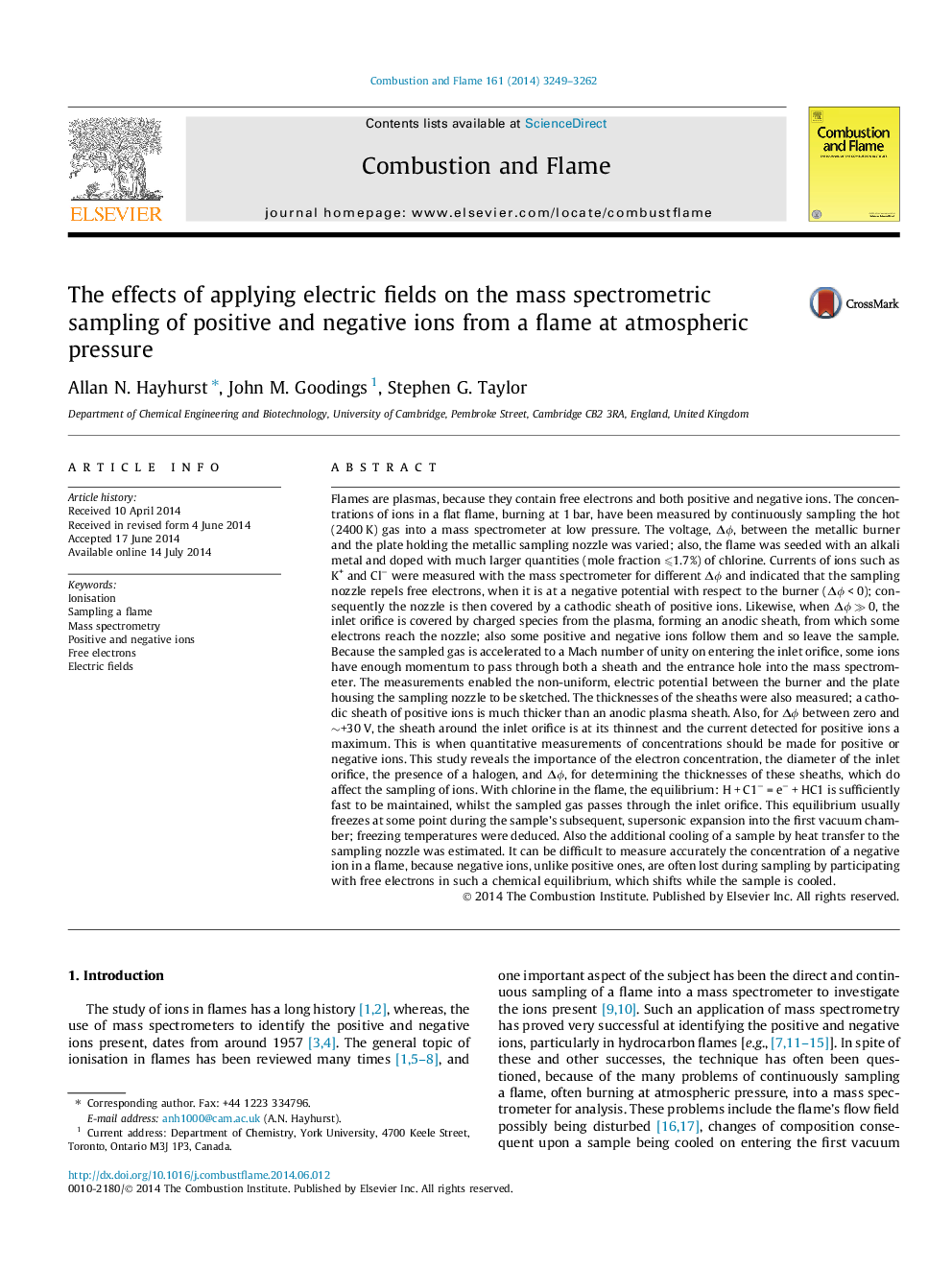| کد مقاله | کد نشریه | سال انتشار | مقاله انگلیسی | نسخه تمام متن |
|---|---|---|---|---|
| 10264398 | 457814 | 2014 | 14 صفحه PDF | دانلود رایگان |
عنوان انگلیسی مقاله ISI
The effects of applying electric fields on the mass spectrometric sampling of positive and negative ions from a flame at atmospheric pressure
ترجمه فارسی عنوان
اثرات استفاده از میدان های الکتریکی بر روی نمونه گیری جرم طیف سنجی از یون های مثبت و منفی از یک شعله در فشار اتمسفر
دانلود مقاله + سفارش ترجمه
دانلود مقاله ISI انگلیسی
رایگان برای ایرانیان
کلمات کلیدی
یونیزاسیون، نمونه برداری از شعله، طیف سنجی جرمی، یونهای مثبت و منفی، الکترون های آزاد، میدان های الکتریکی،
موضوعات مرتبط
مهندسی و علوم پایه
مهندسی شیمی
مهندسی شیمی (عمومی)
چکیده انگلیسی
Flames are plasmas, because they contain free electrons and both positive and negative ions. The concentrations of ions in a flat flame, burning at 1 bar, have been measured by continuously sampling the hot (2400 K) gas into a mass spectrometer at low pressure. The voltage, ÎÏ, between the metallic burner and the plate holding the metallic sampling nozzle was varied; also, the flame was seeded with an alkali metal and doped with much larger quantities (mole fraction ⩽1.7%) of chlorine. Currents of ions such as K+ and Clâ were measured with the mass spectrometer for different ÎÏ and indicated that the sampling nozzle repels free electrons, when it is at a negative potential with respect to the burner (ÎÏ < 0); consequently the nozzle is then covered by a cathodic sheath of positive ions. Likewise, when ÎÏ â«Â 0, the inlet orifice is covered by charged species from the plasma, forming an anodic sheath, from which some electrons reach the nozzle; also some positive and negative ions follow them and so leave the sample. Because the sampled gas is accelerated to a Mach number of unity on entering the inlet orifice, some ions have enough momentum to pass through both a sheath and the entrance hole into the mass spectrometer. The measurements enabled the non-uniform, electric potential between the burner and the plate housing the sampling nozzle to be sketched. The thicknesses of the sheaths were also measured; a cathodic sheath of positive ions is much thicker than an anodic plasma sheath. Also, for ÎÏ between zero and â¼+30 V, the sheath around the inlet orifice is at its thinnest and the current detected for positive ions a maximum. This is when quantitative measurements of concentrations should be made for positive or negative ions. This study reveals the importance of the electron concentration, the diameter of the inlet orifice, the presence of a halogen, and ÎÏ, for determining the thicknesses of these sheaths, which do affect the sampling of ions. With chlorine in the flame, the equilibrium: H + C1â = eâ + HC1 is sufficiently fast to be maintained, whilst the sampled gas passes through the inlet orifice. This equilibrium usually freezes at some point during the sample's subsequent, supersonic expansion into the first vacuum chamber; freezing temperatures were deduced. Also the additional cooling of a sample by heat transfer to the sampling nozzle was estimated. It can be difficult to measure accurately the concentration of a negative ion in a flame, because negative ions, unlike positive ones, are often lost during sampling by participating with free electrons in such a chemical equilibrium, which shifts while the sample is cooled.
ناشر
Database: Elsevier - ScienceDirect (ساینس دایرکت)
Journal: Combustion and Flame - Volume 161, Issue 12, December 2014, Pages 3249-3262
Journal: Combustion and Flame - Volume 161, Issue 12, December 2014, Pages 3249-3262
نویسندگان
Allan N. Hayhurst, John M. Goodings, Stephen G. Taylor,
